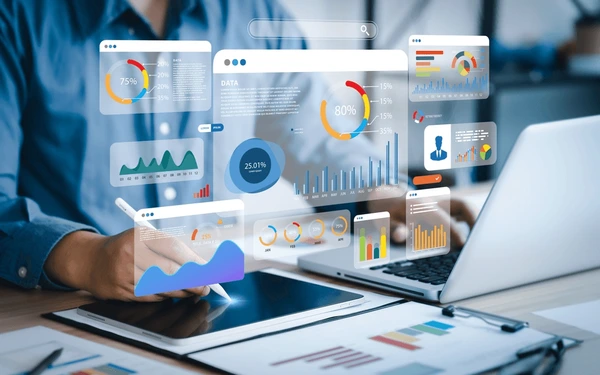What’s New in Web Design for 2024? The Rise of Interactive and Minimalist Design
Web design trends have shifted significantly in recent years, and 2024 marks an exciting period for website creators, designers, and business owners. This year, web design focuses on blending interactive elements with minimalist aesthetics to create captivating, user-friendly, and efficient digital spaces. These trends prioritize user engagement, simplicity, and accessibility, meeting the evolving expectations of digital users. Let’s dive into the latest in web design for 2024, with a focus on interactive and minimalist design principles that are taking center stage.
1. Interactive Design: Engaging Users Like Never Before
Because it offers consumers dynamic and captivating experiences that surpass static images, interactive design is quickly becoming a crucial component of online design. In 2024, interactive elements that react instantly to user input are being added to websites in an effort to build closer relationships with users. Let’s investigate a few trends in interaction:

Micro-Interactions
Small, delicate animations or visual reactions that improve the user’s experience without being overpowering are known as micro-interactions. Icons with subtle motions, form fields that expand when clicked, and buttons that change color when hovered over are a few examples. By providing input, these components help users navigate the website and improve their experience.
Immersive Scrolling
By animating components as users scroll down the page, immersive scrolling produces an engrossing storytelling experience. This effect can offer visual depth, seamlessly transition between sections, or disclose new content. It works well to keep users interested and motivate them to spend more time on the page.
3D and Parallax Effects
Websites get dimension and a sense of reality from 3D and parallax effects, which enhance their visual appeal and memorability. Depth is produced by parallax scrolling, in which background graphics move more slowly than foreground components. On the other hand, the site feels more realistic thanks to the 3D components. Additionally, by guiding the viewer’s eye across a page, these effects can successfully draw attention to important text.
Gamification Elements
Gamification is the use of game-like features, like progress bars, points, or incentives, in web design to increase user engagement and encourage them to perform specific tasks. This trend, which is especially common in e-learning and e-commerce websites, makes use of interactive tutorials, reward badges, and quizzes to make the user experience enjoyable and effective.
2. Minimalist Aesthetics: Prioritizing Simplicity and Functionality
In 2024, a more subtle approach is replacing the classic clean lines and lots of whitespace found in minimalist web design. Nowadays, minimalism places a strong emphasis on user experience (UX) by making sure that each design element has a function.
White Space and Simplified Layouts
The unmarked space between elements on a page is known as whitespace, or negative space. This area allows the design to “breathe,” resulting in a harmonious, uncluttered appearance that draws visitors’ attention to the most important content. Additionally popular are simplified layouts that reduce distractions and properly arrange information to facilitate navigation.
Muted and Neutral Color Palettes
The minimalist design trends of 2024 are moving away from vivid, eye-catching hues and toward more subdued, neutral hues. A serene and elegant look is promoted by the predominance of soft grays, off-whites, soft blues, and earth tones. These color schemes complement the emphasis on minimalism and make key or interactive parts more noticeable.
Typographic Hierarchy
Strong typography is emphasized in minimalism to provide structure and visual interest. Through the use of different font sizes, weights, and styles, designers create a distinct typographic hierarchy that organically leads readers through the content. Sans-serif typefaces are popular because they help create a simple, uncomplicated appearance.
Icon-Driven Navigation
Icons streamline the navigation process, allowing users to navigate more easily without being overloaded with words. Due to space constraints, icon-driven navigation is particularly common on mobile websites. However, in order to produce a more simplified and effective navigation system, icons are increasingly being used in desktop designs instead of traditional text menus.
3. Enhanced User Experience (UX): Focused on Seamlessness and Accessibility
In the world of web design in 2024, user experience is crucial. The following UX-focused trends aid in the development of user-friendly, seamless, and inclusive websites.

Accessibility-First Design
Accessible design is now a top concern rather than an afterthought. People with disabilities can interact with content as efficiently as possible thanks to accessible websites. This entails keyboard-friendly navigation, high contrast writing, unambiguous labeling for interactive features, and alt text for photos. These changes enhance SEO performance in addition to reaching a larger audience.
Faster Loading Times
Particularly on mobile devices, users anticipate that websites will load rapidly. High bounce rates are more likely to occur on pages that load slowly. Load times are decreased by 2024’s minimalist design philosophies, enhanced graphics, and simplified code. Lazy loading is one technique that helps guarantee that consumers view material instantly by delaying the loading of off-screen items.
Personalization
AI-powered customization is being incorporated into modern web design more and more, providing experiences that are customized according to user behavior. For example, personalized greetings, dynamic menus, and content recommendations give each visitor a different experience and help them feel connected to the website. In e-commerce, where customized product recommendations greatly increase user engagement and conversion rates, personalization is especially popular.
Voice User Interface (VUI)
Voice User Interface (VUI) design is becoming increasingly prevalent as smart gadgets gain popularity. By integrating VUI, users can interact with websites using voice commands, improving usability in hands-free scenarios and increasing accessibility for individuals with disabilities. Despite the fact that VUI is still developing, its incorporation into web design is anticipated to become more popular in 2024.
4. Sustainability in Web Design: Prioritizing Eco-Friendly Practices
An industry-wide initiative to lessen the environmental impact of online activities is reflected in sustainable web design. More environmentally friendly websites are being made by designers as knowledge of digital carbon footprints grows.
Light Mode and Energy Efficiency
In recent years, dark mode was popular, but designers are now recognizing that bright mode can sometimes consume less energy, particularly on OLED screens. Mobile users benefit from longer battery life because to energy-efficient designs, which also help to lower overall energy usage.
Minimalistic Media and Resource Optimization
Using less heavy media, like big photos or films, which use a lot of bandwidth, is encouraged by minimalist design principles. To make websites lighter, designers are compressing files, utilizing scalable vector graphics (SVGs), and optimizing photos. Furthermore, reducing the quantity of server requests through the use of lazy loading and caching promotes sustainability.
5. The Role of AI in Web Design: Customization and Efficiency
By enabling personalization, automating tedious activities, and studying user behavior, artificial intelligence (AI) is revolutionizing web design. The following are some ways AI is influencing web design in 2024:
AI-Driven Design Tools
Designers are finding it simpler to produce aesthetically pleasing and useful websites thanks to AI-powered design tools. Based on user preferences and industry trends, these tools can recommend layouts, color schemes, and font combinations, expediting the design process and enabling greater personalization.

Chatbots and Virtual Assistants
AI-powered chatbots are becoming more and more common on websites, offering real-time customer service, responding to frequently asked questions, and even helping with sales. Routine questions can be answered by virtual assistants, which also enhance user experience and free up human resources for more intricate exchanges.
In Conclusion
Web design trends for 2024 emphasize interactive and minimalist design elements that improve user experience, encourage accessibility, and embrace sustainability, reflecting a fusion of art and technology. Websites that prioritize simplicity, functionality, and interaction are aesthetically pleasing, inclusive, and easy to use. Incorporating these trends into your web design plan will enable you to develop a digital presence that appeals to users in today’s ever changing digital landscape, in addition to looking contemporary.







